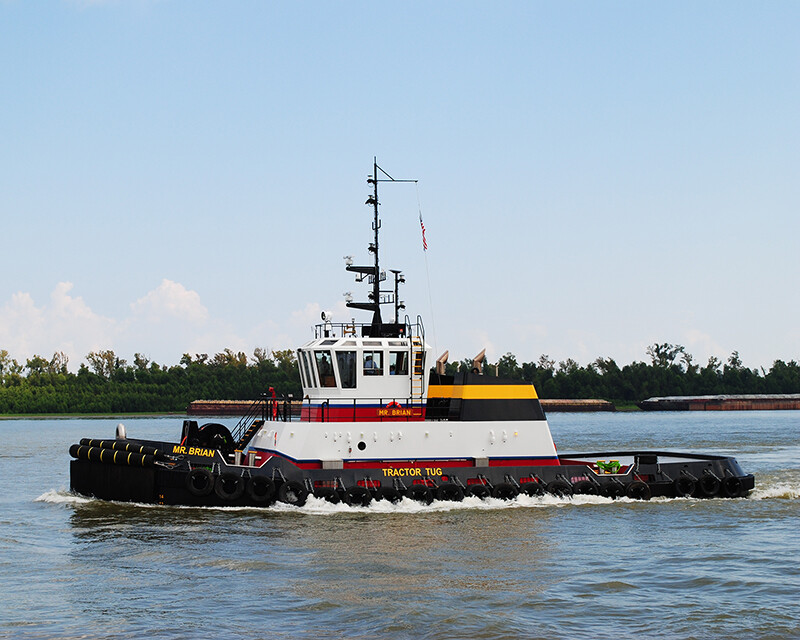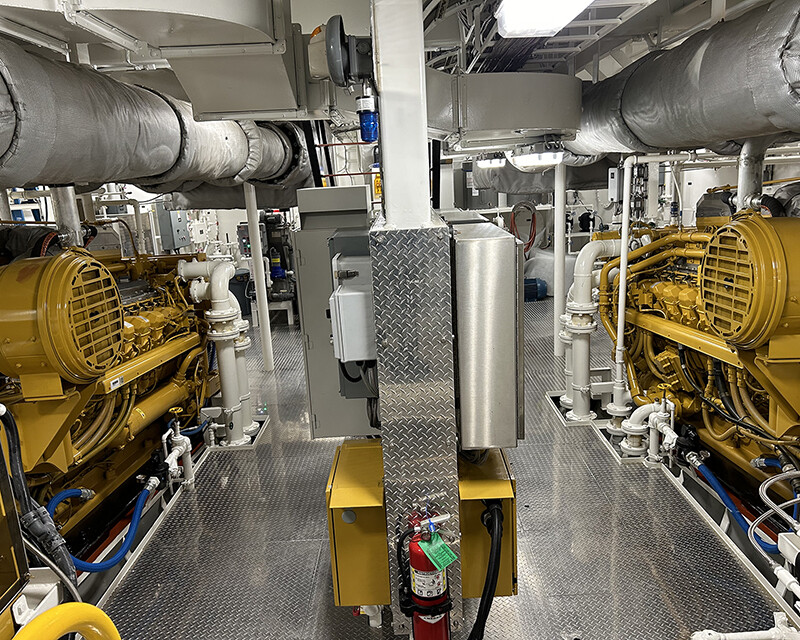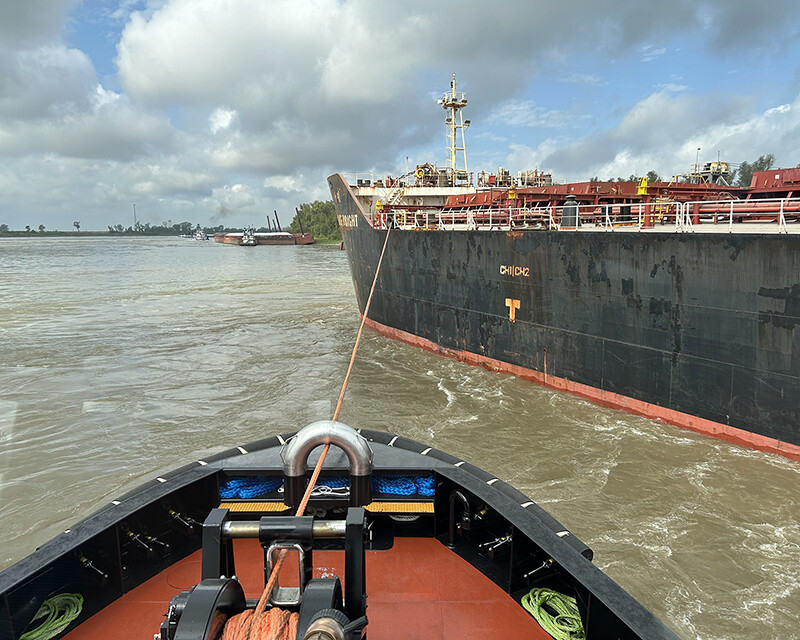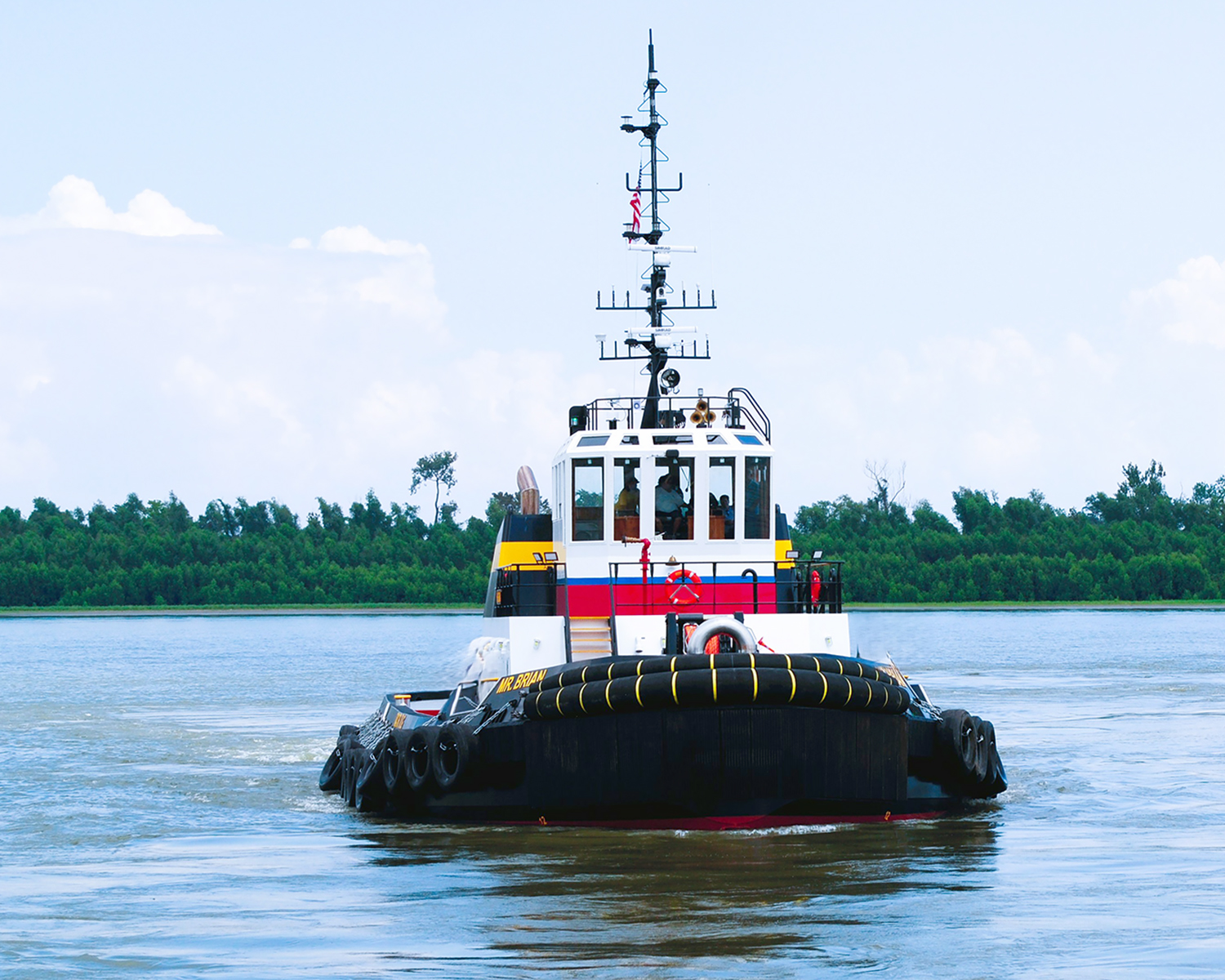I’m following Jonathan Davis into the early morning fog. Davis is Bisso Towboat Co.’s vice president of training, and we’re moving along the company’s steel walkway up and over the Mississippi River levee in Convent, La., between New Orleans and Baton Rouge.
As we come down the other side of the levee, a pair of tractor tugs tied up to a barge slowly become visible in the water, appearing like ghosts out of the mist.

The tug we’re looking for is on the right — the 96'x38'x13'6" Mr. Brian. We hop down to the deck and enter the galley where we’re met by Capt. Keith Blancq and the boat’s engineer, Dalton Kirk. The mate, Austin Bourgeois, and the deckhand, Santino Nuczuillo, are both in their bunks after working the night watch.
I mention how spit and shiny everything is and wonder if it’s the newness of the boat or the time of day or both.
“Oh, no,” said Blancq, “you can come aboard at three o’clock in the morning or three years from now and it will look like this if I’m the captain.”
Davis smiles, shaking his head in the affirmative.
THE BOAT
Bisso operates 10 escort/ship assist tugs, all of which are tractor tugs. “We do have one conventional tug as a backup,” said Davis. “But Scott believes in the tractor tug.”
Scott is Bisso’s owner Scott Slatten. When he decided to add a tractor tug to his fleet in the late 1990s, he travelled all over the world looking for a design that met his needs. He found it in the tug Reliant, a 100'x40' brute designed by Castleman Maritime, Clear Lake Shores, Texas. In fact, Slatten was so taken with it that he eventually bought the design, making improvements to it over the years.
He also found a builder he liked. Main Iron Works LLC, Houma, La., has built all 10 of Bisso’s tractor tugs. The Mr. Brian is the sixth one built for Bisso in the past nine years. The new tug is named in honor of Bisso’s long-time vice president, operations, Brian Cyprowski.
Kirk takes us below to see his engine room. On the way down, Davis said, “The day I first drove a tractor tug I thought about all those years in conventional tugs and all the things I used to wish they could do. These tugs can do those things.”

The Mr. Brian is powered by twin Caterpillar 3516E Tier 4F main engines generating 2,500 hp each at 1,600 rpm driving two Kongsberg US205STK2400FP Z-drives. The Z-drives feature 2,400-mm diameter, 4-bladed stainless-steel propellers in stainless steel nozzles. Estimated bollard pull is 68 tons.
The engine room is eat-off-the-floor clean. Kirk, a man of few words, looks around the area like he just got it for Christmas.
Electrical service is provided by two 118-kW Cat generators powered by Caterpillar C4.4 engines. The tug is equipped with a JonRie series 240 escort winch featuring 500' of 2 ¾" diameter Saturn 12 line.
Other features include Coast Guard-approved engine room monitoring and fire/smoke alarm systems, fixed CO2 fire extinguishing system, Simrad navigation/electronics, soundproof insulation throughout the engine room/crew quarters, stainless steel bitts and bow staple, and four bunk rooms with seven berths.
Tankage includes capacities for 30,162 gals. of diesel, 11,000 gals. potable water, 1,825 gals. each of lube and hydraulic oil and 2,000 gals. of diesel exhaust fluid.
The Mr. Brian carries an ABS International Load Line designation in addition to being built to Subchapter M certification and receiving a Coast Guard COI. “Scott Slatten is in the office every morning for crew change (6 a.m.),” said Davis as we check out the Z-drives, “and he knows everyone by name.”
By the time we check out the rest of the boat and return to the galley, Austin Bourgeois is awake.
“The sun has burned the fog off enough for us to go to work,” Blancq tells us. “Let’s go.”
THE JOB
Blancq cranks up the big Cats and pulls away from the dock, chasing sister tug Alma S that peeled away from the dock ahead of us headed south.
As we make our way, I ask Davis about any personnel issues for Bisso. “We haven’t really experienced that like some others because we keep our crews together, keep the same people together,” he said. “And we don’t hire outside captains. Loyalty is a two-way street. So, people want to stay.”

We make our way to the Zen-Noh Grain Feed dock where we must provide a ship assist for the Chailease Bright, a Liberian-flagged 738’x105.7’ bulk carrier. The actual job order was “turn for sea from Zen-Noh Grain.”
We reach the dock under bright sunshine. The Alma S took up a position on the port side near the stern, and we’re “port bow, break of the focsle,” Davis told me. Meanwhile, Blancq was having a conversation with the pilot aboard the bulk carrier.
The dock is a hive of activity. Zen-Noh is a New Orleans company, established in 1979, that supplies corn, milo, soybeans, and other foodstuffs to produce compound feed around the world from its mills in Japan.
Activity aboard the ship begins to pick up. Kirk pops out the wheelhouse and hooks a line that the ship’s crew has lowered to the tug’s line and the ship’s crewmen bring it up and we’re attached.
Blancq looks at me. “Good old know-how.”
The pilot from the ship’s wheelhouse gives Blancq a direction. I can’t make it out. “He wants us to go to a 45.” Blancq moves the tug until the line from the ship to us is at a 45° angle.
Kirk is back in the wheelhouse with us, and it’s quiet until the ship’s pilot says all is ready. Mr. Brian will tug the bow of the Chailease Bright, which is pointing upriver, around while the Alma S keeps the ship’s stern where it is as it moves away from the dock.
The engines come to life again, and the Mr. Brian begins to pull, the Cats growling differently than they did when they were pushing the tug by itself. Pulling the ship’s 41,684 gross tons sideways across the river’s current makes the wheelhouse floor shake and the windows vibrate.
Blancq is hyper-focused but calm, moving the controls with professional dexterity. The bow struggles to move away from the dock, but the Mr. Brian is insistent. Finally, the bow can resist no more, and it swings into the center of the river. The Alma S takes up its position off the ship’s stern.
Chailease Bright is now facing downriver, towards the Gulf of Mexico. Kirk pops out of the wheelhouse again to unhook the tug’s line, and the captain reels it in. Blancq swings the Mr. Brian around, then turns and looks at me. “Well, that’s what we do,” he said.

In the truck on the way back to New Orleans, Davis said, “You know, most people have no idea what these guys do out here every day and how much it affects their lives. But I guess that’s OK.
“I’ve been working for Bisso for more than 40 years, and I still like my job. These are good people. And every now and then, I’ll take a shift for somebody, and I get to drive the boat. That’s when I really like my job.”
My sincere appreciation goes to Scott Slatten, John Davis, and Capt. Keith Blancq and the crew of the Mr. Brian for taking me on as ballast for half a day in October.
MR. BRIAN SPECIFICATIONS
Owner: Bisso Towboat Co.
Builder: Main Iron Works
Mission: Ship Assist
Length: 96’
Beam: 38’
Depth: 16’6”
Draft: 13’6”
GRT/NRT: 199/136
Speed (knots): 13
Main Propulsion: (2) Caterpillar 3516E, 2,500 hp @ 1,600 rpm
Z-Drives: (2) Kongsberg US 205STK2400FP
Propeller: (2) Stainless steel, 4-bladed, 94.5” dia.
Bollard Pull: 66 tons (estimated)
Gensets: (2) Caterpillar C4.4 engines, 118 kW
Hull Construction: Steel
Capacities (gals.): Fuel oil, 30,162; potable water, 11,000; lube oil, 1,825; hydraulic oil, 1,825; diesel exhaust fluid, 2,000
Electronics: Simrad HALO-4 radar, Simrad NSO EVO3 heading device, Simrad AP70 MK2/Rose Point navigation software, Simrad IS42 weather station, Simrad Airmar B45 fathometer; FLIR thermal camera/radar; Navionics platinum chart plotter; Furuno FA170 AIS, Furuno LH5000 loudhailer, Furuno BR 500 wheelhouse alert, Blue Box cube system audio recorder; Unlimited Control & Supply 78-point engine room monitoring/alarm system; Fireboy Xintex USCG-approved fire/smoke alarm system
Firefighting: 500 gpm monitor powered by 4” pump/25-hp motor
Fire Suppression System: Herbert Hiller fixed CO2 fire suppression system
Fendering: Schuyler 24” OD cylindrical bow fenders
Bow Winch: JonRie 240 hydraulic with 500' of 3" diameter Saturn 12




